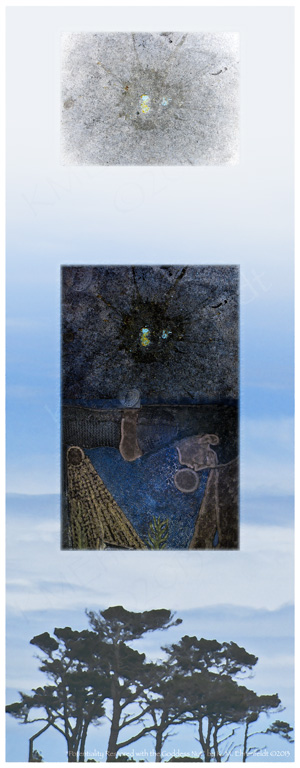Does photographing the dead baby bird for art’s sake give meaning to a life cut so short, or does the photographic act matter at all? Those philosophical concerns bear no weight in comparison to the tenderness of those moments — to the messages contained in that interplay of a life scrutinizing a death. Photographs of those ruined birds and eggs found artistic resolution in painterly retouching and compositing. In combining the birds with skies, Egyptian symbols and archetypes, ultimately these pictures became painterly images of transcendence.
The Lost Dreams series is digital in origin and takes form as archival pigment prints on textured archival paper. The photo origins and cameras used reveal artistic process in the significance of travel and creativity beyond studio walls, the immediacy of perception, and how exploring various surroundings resonate with artistic themes in play. Also, that as a mixed-media artist, whatever camera is present becomes the artist’s tool. I never sought out dead birds to photograph; whatever appears here emerged upon the path, caught my sight, and lingered in my mind. The subject matter is dark, usually we avert our eyes to such things, but who can say why inspiration calls the mind toward one subject or another, or why the subject itself may beckon attention and regard. In working the creative process the time simply arrived to ponder the questions the birds posed… to think about lost dreams in life, and to make art out of images and reflection.
I’ve found that middle age is partly a threshold for reconciling what has come to be with what we assumed and envisioned at a young age. Each of these paintings holds a tender meaning for me of a lost dream, significant dreams for my life. As I’ve crafted each painting, I’ve regarded that part of a desired life I’ll never have or haven’t attained, loving what could have been as I let it go. This is what art does for the artist, the process cultivates, heals, inspires anew, makes whole — a movement through sorrow into light. As for the baby birds, nature never wastes a life; their tiny bodies fed others in the process of returning to dust and earth once again.
As I worked with the bird images, I was drawn to pairing each with an Egyptian archetype, it was an intuitive pull that made perfect sense. There is, in the reconciling of personal losses, an opportunity to raise awareness to what has become instead, or what of it can still become. In our middle age, we are meant to grieve, to let go — to bring forth the seed of whatever potential still remains into a new form. Otherwise we’re still banging away at youthful hints of who we thought would become, which were likely influenced by other people anyway. Instead we must reframe our vision, for it is out of seeing who we’ve become that we can tell who we have yet to be, and what dreams are still to manifest. With realization of those dreams or aspirations that still have potential, it’s possible to move forward less encumbered by youthful expectation or internal criticism of the process. We may enjoy the journey for it own sake.
People have been trying to raise the lost dream of Ancient Egypt for over a century: mapping and charting, uncovering its temples and tombs, revealing its artifacts and archetypes, translating, transcribing, x-raying, restoring, re-enacting… meditating. In reality, the ancient mythology is lost for all time and its vital significance with it. No one has heard its songs for thousands of years. No modern mind outside the culture of those times can recreate it in its original expression and intent. With Ancient Egypt, essences are all that remain, some potency of that time relevant to a new time, newly evolving, as it should be. Similarly as I’ve grown and aged, the unrealized youthful dreams are lost to the sands of time, and only some essence may still be born into my life at this time. The essence only of some, others are simply gone for all time; in this way the artistic process correlates the inner and external worlds.
The beckoning of the Lost Dreams work began long before to my trip to Egypt in 2006. Then, with the first photos in 1999 that became Ancestral Bones and Choices, and I had no idea the images and archetypes I’d encounter in Egypt were connected to that longing and sense of loss that was brewing. I was sitting on those images knowing some body of work was brewing. Over the course of nine years other fallen birds crossed my path, their images captured, and in time I did begin to grieve over these lost dreams of mine, not solidly, but a relentless revisiting, forcing me to deal with the issue completely, until it was fully resolved or a vision of myself reframed. At first I worked with the baby bird images regarding them in sharp light, not unlike the harsh criticism over my own choices in life or lack of choosing that cost me dearly. Later, in a more forgiving state of mind, these little birds needed a gentle regard.
It wasn’t until recently, when this body of work took artistic priority that image met image in my mind, making perfect sense to combine. I suppose in this way, while I resolve my own lost dreams, I help in restoring an ancient essence to newfound significance. Divinity touches mortality, imbues with some potency of a gift to enable emotional and physical transformation. And while I’ve not articulated the specifics of my own losses, it is hoped that these images will speak to viewers of their own personal concerns, for the themes are all part of the human condition. The physical and spiritual, and the realms of heaven and earth meet in the imagery of these pieces, and art becomes an instrument of renewal.
K. M. Ehrenfeldt 3/13/2013
